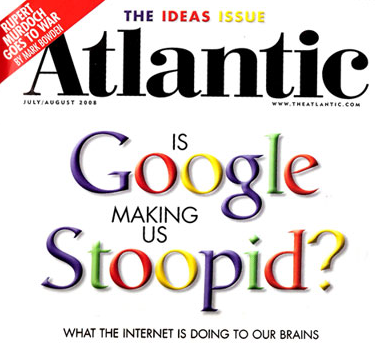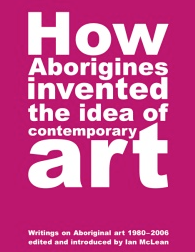Index Prior to 2010
 Monday, August 2, 2010 at 11:54AM
Monday, August 2, 2010 at 11:54AM Follow this and succeeding pages for the full archive of this web site.

Can Machines Dream? (Five Parts)
The Magic of Apple is Really About the Magic of Design
Reflections on New Media (Nine Parts)
Artficial Worlds and the Cinema
Brain Images, Neurosciences, Cultural Theory
Bad News, Richard Posner and New Media
Research in the Arts and Design
The Practice of Interdisicplinarity in Design and New Media
Ceramics in the Material World
Dilemmas of Teaching and Learning
True Blood and the Culture of Vampires
Virtual/Real/Virtual (Three Part Series)
Social Networks and Virtual Communities
A Shallow Argument: Nicholas Carr + the Internet
Indigenous Images + Stories: The Case of Eric Michaels
Digital Culture Notes (First of a series)
From Quantum of Solace to Sherlock Holmes
Robert Frank and American Photography
From Community Media to International Networks
Reflections on the Documentary Cinema

There are three major essays on Roland Barthes within this web site.
Roland Barthes, Camera Lucida and Cultures of Vision
 Monday, August 2, 2010 at 11:54AM
Monday, August 2, 2010 at 11:54AM Follow this and succeeding pages for the full archive of this web site.

 Monday, July 12, 2010 at 5:23AM
Monday, July 12, 2010 at 5:23AM A recent blog post by one of my favourite writers, Alexandra Samuel and an article in the New York Times about some research which suggests that teenagers who use the Internet at home are less likely to have good grades at school has motivated me to start a new series on Social Media.
 Saturday, July 3, 2010 at 5:32PM
Saturday, July 3, 2010 at 5:32PM Let’s assume for a moment that everyone is capable of being creative. This is a fair assumption based on an egalitarian model of human development. To varying degrees, people respond to complex situations in very
creative ways. But is this enough to make the suggestion that everyone can translate creativity into expressive forms with the power and import of art?
 Emily Carr University of Art + Design
Emily Carr University of Art + Design
For example, art schools are hotbeds of creative engagement and, wherever they are available, their community based creative courses attract a wide variety of the populace. Most people I speak to have a deep attraction to art and to artists. Many individuals harbor a secret desire to become artists. The same is true of the attraction to writing. One thing that is often forgotten in discussions of the period of history we live in is that the proliferation of web sites and blogs is perhaps one of the best indicators of the universal desire to create and communicate. This desire crosses national boundaries, class differences and religions.
The questions that flow from this seemingly superficial assumption about the universal desire to be creative are many, but among the most important is what do we mean by creativity?
First and foremost, creative engagement means producing something new and, most importantly, engaging with the world through less linear and unpredictable means than the constraints of everyday life often allow. The ephemeral nature of discovery combined with excitement of working with ideas and materials, encourages fluidity of thought and an almost child-like excitement about simple acts like shaping paper into a sculpture or creating movement from drawings that are still.
Artists are compelled to create. Their lives are burdened by the fact that there are rarely any alternatives to the depth of desire that they feel — the physical and mental need to explore their chosen craft or medium. Most writers cannot pass a day without engaging with words and sentences. Yet, not everyone is a writer or artist.
So, although everyone is capable of being creative, very few exercise their talent to the point of making creative engagement the centre of their lives. This is because the translation of creative desire into forms or
materials requires a further step beyond the spontaneous production of artifacts. The secondary act of speculative and critical thinking that needs to be applied to creative production requires a profound understanding not only of history, but also of our place in history.
Painters come to an intimate understanding of the materials they use in the context of the history of art. The intellectual work that is necessary here far exceeds popular notions of spontaneous inspiration. Take a hard look at the many letters which Vincent Van Gogh wrote, and you see a man devoted not only to explaining his art but also to communicating his intentions. Alternately, take a look at the many letters that Samuel Beckett wrote, and you become a witness to his intense and sometimes violent need to communicate his
views of the world.
In all of this, art is produced through action and reflection, through interchange and community. Practice, repetition and rigour transform working with materials, ideas and media into complex acts of communication.
Creativity is therefore about more than what we do or how we think. It is about the application of knowledge to the production of artifacts, ideas and even moments in time. Everyone can be creative, but not everyone wants to spend the time and energy engaging with the demands that creative production requires.
 Art,
Art,  Creativity in
Creativity in  Creativity
Creativity  Friday, July 2, 2010 at 8:14AM
Friday, July 2, 2010 at 8:14AM 
Among its many errors of logic and argument, Nicholas Carr's book, The Shallows: What the Internet Is Doing to Our Brains suggests that the plasticity of the brain — its malleability, means that the generation now heavily involved with, and indebted to the Internet, is having its brains rewired. Aside from the obvious problems in talking about the brain as an electrical system, the supposed plasticity of the human brain is far from being proven although it is in an important area of research in the neurosciences. It is true that the brain is far more capable of adaptation than previously thought, and there is evidence to suggest that learning at all stages of life contributes to a "healthy" brain. However to draw the conclusion, as Carr does, that we are in the midst of a crisis which is redrawing the boundaries of how people think (and most importantly what they do with their thoughts) is alarmist and counter productive.
Carr's panic at what is happening to "us" — distracted multitaskers who no longer read or experience the world with any depth or rigour — perpetuates the century's old hysteria about the effects of new technologies on humans. Stephen Pinker, who actually does research in the neurosciences skewers the simplicity and reductiveness of people like Carr in a recent New York Times article. He says, "Critics of new media sometimes use science itself to press their case, citing research that shows how “experience can change the brain.” But cognitive neuroscientists roll their eyes at such talk. Yes, every time we learn a fact or skill, the wiring of the brain changes; it’s not as if the information is stored in the pancreas. But the existence of neural plasticity does not mean the brain is a blob of clay pounded into shape by experience."
Of even greater interest is Carr's transformation of Darwin's theories of evolution into claims about the speed with which the Internet is altering human biology. This fast forward approach to human evolution has its attractions. After all, humans were not around to witness millions of years of evolution, so it is easy to draw simplistic solutions to explain shifts in human activities and modes of thinking.
Carr's moral panic (taken up and reproduced by hundreds of journalists in newspapers and blogs seemingly desperate for some explanation as to why they are hooked to a medium they haven't thought about with enough depth and historical range) suggests that evolution is like Lego blocks. Once you put a few blocks into place, you have a structure, and once you have a structure, presto! you have evolved!
Carr's argument is just a variation on intelligent design. Replace god with the Internet and you have a power so great that humans are not only its victims, they are growing new brains to accommodate its vicissitudes.
Why do balkanized versions of genuinely interesting and important research projects into human adaptability get transformed into this type of discourse? It is probably not sufficient to suggest that every new technology generates panic among those who least understand either its present use or future transformation.
After all, had Carr taken even a minimum peak at the 19th century, he would have noticed that among other assertions, the telephone was described as a killer of conversation and human interaction (an attitude that lasted well into the 1960's). He would also have noticed that the cinema was described as a terrible distraction that among its many effects would probably lead to the death of literature and theatre. Photography was lambasted for its potential to lie and convince the gullible masses that the truth of an event could be found in images.
But, Carr is not the problem here; he is merely symptomatic of an ever growing and worrying trend to ahistoricism among so called public intellectuals. Those who should be the most sensitive to the nuances of change and the shifting relationships among individuals and their communities and the communications technologies they use are now sanctimoniously declaring that the public is being dumbed down. Carr, of course, never spent any time doing an empirical study because it would have taken him years to complete. He accuses internet dwellers of swimming in a sea of illusions without asking any hard questions about how he came to that conclusion.
His lack of attention to history is what he suggests internet users have devolved into, and, in so doing, he imposes on this vast and ever changing community with all of its diversity and multi-national character a superficiality of intent that he himself creates with his own very shallow arguments.
 Saturday, June 26, 2010 at 8:10AM
Saturday, June 26, 2010 at 8:10AM I will weave through a series of juxtapositions in this blog entry drawn from a number of experiences which I have had in the "field" of ethnography and documentary film — a kind of bricolage — or as James Clifford has put it, an 'ethnographic surrealism'.(1)
In retrospect these fragments are linked in ways which I could not have anticipated before I made the attempt to understand the connections. This kind of reconstruction interests me because it is a combination of personal history, fieldwork and theoretical exploration, evidence of an effort to explore and map the relationships among subjectivity, analysis and experience.
The etymological origin of the term documentary is rooted in the notion of the lesson and is connected to docility, doctrine, indoctrination and didacticism. Docility suggests someone willing to be taught and also someone who is teachable. To be responsive, to be taught, to be open to the information which is presented — information which, if it is to function as document must reproduce in as great detail as possible the world being pictured.
Search a bit further into the etymology and the stronger connection is to doctrine and indoctrination which have roots not only in teaching but in notions of specialization — in the idea of a specialist able to instruct, someone whose knowledge cannot be questioned, the documentary filmmaker.
I bring up this tableau of origins because although a consensus has developed around the definition of "documentary" the debate at this stage pivots on questions of realism almost, though not completely, in opposition to questions of pedagogy. Documentaries however, exist as object lessons in themselves of a desire to teach and thus to enter into a system of communication (or to create one) which links images with specific outcomes or results. The instrumental logic of the documentary is so deeply ingrained that the technology of image creation is now geared to increasing the probability of specific effects upon the viewer.
I am speaking here about the hybridization of light-weight video, film and computers, a kind of postmodern brew designed to make the experience of viewing more immersive, hence more real.
Let me contrast the above with the work of Eric Michaels, a documentary/ethnographic imagemaker who worked in Australia with Aboriginal peoples. He died in 1988 but the impact of his undertaking will continue to be felt for a long time. His essays and his brilliant monograph entitled, *Aboriginal Invention of Television* (1986) reveal a sensibility closely tied to some radical innovations in documentary and ethnographic thought over the last decade. (2)
Michaels explored the frontiers of one of my major interests, the impact of video and television on indigenous cultures. He achieved this by rethinking the notion of "effects" — the ways in which Western cultures control and attempt to dominate other societies — and not positing anything like a linear model for what happens when new technologies are thrust upon indigenous peoples. Michaels worked on both sides of a complex process. He was aware of the need for indigenous peoples to take control of the media they were being exposed to. He was also very sensitive to the specific choices, which they made with respect to images. His approach interests me because he questioned the roots of instrumental thinking by looking at the way in which another culture responds to the logic of images — to modes of storytelling and representation.
His insights in this regard are very significant. In his essay on Hollywood iconography (Michaels 1988:119) Michaels points out many of the radical differences in understanding, which the Aboriginal group, the Wapiri have with regards to American films and television. Not only are the plots dealt with differently, but the characters in these films are reinterpreted according to the specific exigencies of Walpiri culture and social life.
All of this is of course a way of questioning the role of documentary images precisely as devices of teaching and learning that may have cross-cultural value. It is also about how to analyse the strategic choices, which different cultures make in response to the influences, which they have on each other. The question of vantage point — where and how these choices can be examined was a central concern of Michaels. He tried to draw upon the experiences of non-print media and apply them to the process through which ethnographic knowledge is transferred and transformed into visual and oral documents. He noted the specificity of Aboriginal approaches to images and celebrated the differences in how they interpreted documentary claims of truth and realism.
This is made very clear in his article entitled, "How to Look at Us Looking at the Yanomami Looking at Us," (3) in which he says: "A solution is to address the entire process of visual media as a problem of communication, more specifically in cross-cultural translation." (Michaels 1982:145)
It may be that nothing of value to indigenous cultures can be yielded in the process of translation and that the role of visual media is more important for Western cultures than for colonised ones. But this would presume, as Michaels so often pointed out, that colonised cultures themselves have somehow escaped the influences of modern media, which as anyone who has been watching the growth and development of video for example, knows is not the case.
This still doesn't lessen one of the central dilemmas of ethnographic and documentary work with film and video. For the ethnographer it may be more important to uncover both the applicability and effects of the technology than to let the technology work its way through the society in question and let that society find the measure of its own response.
I think that it would not be too radical an assertion to say that the response of indigenous cultures to cultural phenomena cannot be ascertained clearly until those cultures have devised strategies of response, whatever form those responses might take.
Working its way through — what do I mean? A process perhaps which may not be open to external examination and without wanting to push the point too far, a process which may produce forms of internal and culturally specific images which cannot be judged, evaluated or examined from the outside. I want to be careful here because I am not suggesting that a vantage point couldn't be found which might permit one culture to examine another, but there is the matter, and I consider it to be an important one, of how we go about understanding our own history with respect to modern media, let alone the history of other cultures.
There is a tendency, manifest in many ethnographic and documentary projects but even more so when film and video are put to use, to presume that what other cultures choose as images can actually be translated, and it is this presumption which I think needs to be contested because what is inevitably involved are complex sign systems which our own culture has had difficulty in interpreting for itself let alone for others.
This is a fascinating and perplexing problem. It suggests a kind of opaqueness, which the universalizing tendencies of modern film and television production have not grappled with. We need to celebrate the complex and rather 'different' images, which the Aboriginal peoples of Australia have produced, and which Eric Michaels documented. (3)
(1) See Chapter Four of *The Predicament of Culture* (1988) in which Clifford argues for a redefinition of the history of surrealism in order to show the close if not parallel development of ethnography and surrealist thinking.
(2) I am thinking of the work of Edmund Carpenter (1970); James Clifford (1988); Jean Comaroff (1985); Vincent Crapazano (1980); Michel De Certeau (1984); Johannes Fabian (1983); Clifford Geertz (1988); George Marcus and Michael Fischer (1986); Paul Rabinow (1977).
(3) Eric Michaels (1982). This is an essay in a superb collection edited by Jay Ruby, entitled, A Crack in the Mirror (1982).